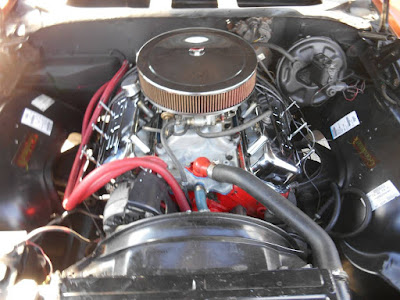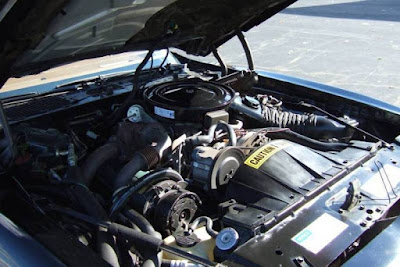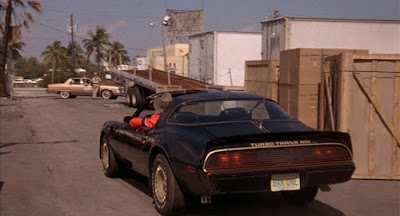I didn't share Motor Trend's enthusiasm for the styling of Ford's 1983 "aero" Thunderbird and trust me, this October 1982 magazine cover is a gift from the darkroom gods - Ford wished the car looked this good. All could or would be forgiven, to some degree in my eyes, if Ford offered the Thunderbird in a powerful, range-topping, sporty model.
Well, they did but they screwed that up too. Our subject is a "first generation" Ford Thunderbird Turbo Coupe from 1985 resplendent in aftermarket baubles that, except for that what-the-hell spoiler, do make the car look better. Kind of.
The problem with Turbo Coupe was that it's namesake, this turbocharged 2.3 liter inline four cylinder engine, didn't offer any better performance than what could be provided by the 5.0 liter V-8 that was also available. Handling may have been marginally improved with the lighter four-cylinder compared to the V-8 but the added cost and complexity of the turbo negated any upside. Ford didn't iron out any of the 2.3's inherent vibration either making for an engine with all of the charm of a garden tractor.
Turbocharged cars, even the best of them to say nothing of relatively primitive setups like our subject here, are finicky contraptions with significant trade offs like "turbo lag" and a lack of low end responsiveness. I've yet to drive even a state-of-the-art modern turbocharged car and find it superior in overall drivability to a non-turbocharged car. Call me old-fashioned or over the hill but I much prefer the flat, linear torque curve of non-turbocharged or what is referred to as normally aspirated engines. I also don't find the alleged trade offs to be worth my money either - most that I've driven use as much or more gas than larger engines making the same power. What's the point of that?
I wished Ford used their wonderful 5.0 liter "High Output" V-8 from the Mustang GT in this car instead. Allegedly, because of some Ford edict that mandated that no Ford car could be "faster" than the Mustang GT, a range-topping Thunderbird had to be literally hobbled. As if a Thunderbird with the 5.0 H.O. could outrun a Mustang.
There was also conjecture that the H.O. V-8 would turn the Thunderbird into a gas guzzler. Interesting. Contemporary road tests of 1983-1986 "first generation" Ford Thunderbird Turbo Coupes pegged the car at 14 miles per gallon combined city and highway driving. Would the big V-8 have been that much worse on gas? Again, the point of this car?
Well, the point of the car was to make the Thunderbird brand even more compelling to buyers of import and makes and models. "Turbo" was a magical marketing ploy, ala Porsche and Saab, and was meant to evoke European je ne sais quoi. We are talking the mid 1980's here which was when Baby Boomers were coming of age that they could start buying whatever they wanted - and they wanted BMW's and Mercedes Benzes not anything, let alone a Ford Thunderbird of any ilk, domestic.
These Thunderbirds, which were made through 1988 with significant styling and engineering improvements for 1987, ultimately appealed almost exclusively to Ford, domestic and "sporty" two door car lovers and did little to off set the literal sea change that was occurring in the auto industry at the time.
That change in the auto industry was more than just Boomers flocking to imports. Even by 1985 the market for two door cars in general was shrinking to say nothing of what was happening to vestiges from the 1970's personal luxury car boom market. Ford replaced this car in 1989 with a larger, heavier car, whose styling I really, really liked but it sold poorly because, again, the market for coupes was shrinking; Thunderbird fed to the shredder for good after 1997. Oh, and I don't count the 2002-2005 clown suit as a "Thunderbird".
Je ne sais quoi literally means "I don't know what"
Turbocharged cars, even the best of them to say nothing of relatively primitive setups like our subject here, are finicky contraptions with significant trade offs like "turbo lag" and a lack of low end responsiveness. I've yet to drive even a state-of-the-art modern turbocharged car and find it superior in overall drivability to a non-turbocharged car. Call me old-fashioned or over the hill but I much prefer the flat, linear torque curve of non-turbocharged or what is referred to as normally aspirated engines. I also don't find the alleged trade offs to be worth my money either - most that I've driven use as much or more gas than larger engines making the same power. What's the point of that?
I wished Ford used their wonderful 5.0 liter "High Output" V-8 from the Mustang GT in this car instead. Allegedly, because of some Ford edict that mandated that no Ford car could be "faster" than the Mustang GT, a range-topping Thunderbird had to be literally hobbled. As if a Thunderbird with the 5.0 H.O. could outrun a Mustang.
There was also conjecture that the H.O. V-8 would turn the Thunderbird into a gas guzzler. Interesting. Contemporary road tests of 1983-1986 "first generation" Ford Thunderbird Turbo Coupes pegged the car at 14 miles per gallon combined city and highway driving. Would the big V-8 have been that much worse on gas? Again, the point of this car?
Well, the point of the car was to make the Thunderbird brand even more compelling to buyers of import and makes and models. "Turbo" was a magical marketing ploy, ala Porsche and Saab, and was meant to evoke European je ne sais quoi. We are talking the mid 1980's here which was when Baby Boomers were coming of age that they could start buying whatever they wanted - and they wanted BMW's and Mercedes Benzes not anything, let alone a Ford Thunderbird of any ilk, domestic.
That change in the auto industry was more than just Boomers flocking to imports. Even by 1985 the market for two door cars in general was shrinking to say nothing of what was happening to vestiges from the 1970's personal luxury car boom market. Ford replaced this car in 1989 with a larger, heavier car, whose styling I really, really liked but it sold poorly because, again, the market for coupes was shrinking; Thunderbird fed to the shredder for good after 1997. Oh, and I don't count the 2002-2005 clown suit as a "Thunderbird".
Je ne sais quoi literally means "I don't know what"


















































